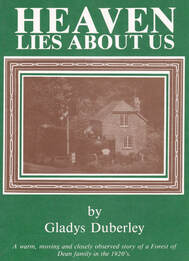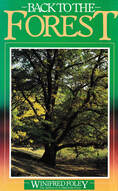Landscape and the Natural World
Using the work of Forest of Dean authors and poets to inspire young writers
Using the work of Forest of Dean authors and poets to inspire young writers
Landscape and Nature
This extract is taken from the poem Woods by Leonard Clark. It appeared in his collection English Morning and Other Poems (1953).
My heart is ever with woods.
In them there is no argument of words,
No counting time, no calculations of oneself,
But wandering insects and birds,
The light falling of leaves,
The silent speech of trees.
O, once I knew a deep and lovely wood
And often on its spreading floors I walked
And heard no echoing steps but mine.
I used to sit on green-mossed banks
Dangling my feet in tides of running fern;
In morning glades I stood
As overhead the pigeons talked
Their endless, muffled words;
The pheasant screamed amid the undergrowth
And troops of warring ants fought battles all day.
And there were tiny waterfalls at work
Far in some dropping stream beyond the wool-tagged wire,
Butterflies than sunned themselves on speckled stones,
Shrews and solitary bees,
The charcoal-burner’s fire.
© Leonard Clark (1953)
My heart is ever with woods.
In them there is no argument of words,
No counting time, no calculations of oneself,
But wandering insects and birds,
The light falling of leaves,
The silent speech of trees.
O, once I knew a deep and lovely wood
And often on its spreading floors I walked
And heard no echoing steps but mine.
I used to sit on green-mossed banks
Dangling my feet in tides of running fern;
In morning glades I stood
As overhead the pigeons talked
Their endless, muffled words;
The pheasant screamed amid the undergrowth
And troops of warring ants fought battles all day.
And there were tiny waterfalls at work
Far in some dropping stream beyond the wool-tagged wire,
Butterflies than sunned themselves on speckled stones,
Shrews and solitary bees,
The charcoal-burner’s fire.
© Leonard Clark (1953)
Harry Beddington usually wrote in Forest dialect, but here he chooses to write in ‘standard-English’ as he locates the Forest landscape. It first appeared in Forest of Dean Humour (1961) then in Forest Humour (1977).
|
The Forest of Dean
Where lordly cliffs surrender winsome Wye And Severn spreads wide arms to greet his bride Greenly uplifted ‘gainst the sky The Royal Forest reigns in ancient pride. Serene in scented airs the west wind brings Greeting the sunrise over Cotswolds blue Or, westward, fronts the grander slopes of Wales While quiet streams and birdsong fills her vales. The roystering sou’ wester’ she curbs with outflung arm As strong limbed oaks and beeches take the strain Her furious foaming birches froth the wild alarm And tall spruce roar in sonorous refrain. Clad in green and russet, watchfully at rest, Silver-girdles Verderer, Warden of the West. © Harry Beddington (1977) |
Plants and Animals

Gladys Duberley was born in 1911. When her father returned injured from World War One the family moved from Littledean to Soudley. In this extract from her memoir Heaven Lies About Us (1978) p6, she remembers Sunday walks in the countryside and the various – sometimes edible – plants to be found.
As summer came, we sometimes ventured out for Sunday walks, my sisters and I in our Sunday dresses. Going farther along the hill where the hard road came to an end and disappeared into footpaths going their various ways through the forest, you could turn left and go up an ash path. Here your way was barred by a stile, over which you climbed and found yourself waist-high in tall grass ready for mowing. Here you could gather moon daisies and quaking grasses. They lasted a long time. There were also small pieces of herbage which you could eat. Sorrel which had tall red leaves with seeds on top. If you picked the tender leaves at the vase and chewed them they were sharp and tasty. We called it ‘sour Sally’. Another favourite had tiny white bell flowers and folded heart shaped leaves, very pale green. It was called wood-sorrel with a delicate acid taste. The stems were fragile and paley pink.
The briar roses were I think the most beautiful. They grew over the hedges in profusion, starring the hedge with single roses varying from delicate shell pink to deepest rose.
No good picking these, the stems were excessively thorny but if you could find a young stem, only just spurted, you picked it carefully, skinned it and ate the centre – sweet and bitter at the same time, we called it sweet briar.
The first fresh green leaves of the hawthorn hedge were also edible and tasty. We called it bread and cheese.
© Gladys Duberley (1978)
As summer came, we sometimes ventured out for Sunday walks, my sisters and I in our Sunday dresses. Going farther along the hill where the hard road came to an end and disappeared into footpaths going their various ways through the forest, you could turn left and go up an ash path. Here your way was barred by a stile, over which you climbed and found yourself waist-high in tall grass ready for mowing. Here you could gather moon daisies and quaking grasses. They lasted a long time. There were also small pieces of herbage which you could eat. Sorrel which had tall red leaves with seeds on top. If you picked the tender leaves at the vase and chewed them they were sharp and tasty. We called it ‘sour Sally’. Another favourite had tiny white bell flowers and folded heart shaped leaves, very pale green. It was called wood-sorrel with a delicate acid taste. The stems were fragile and paley pink.
The briar roses were I think the most beautiful. They grew over the hedges in profusion, starring the hedge with single roses varying from delicate shell pink to deepest rose.
No good picking these, the stems were excessively thorny but if you could find a young stem, only just spurted, you picked it carefully, skinned it and ate the centre – sweet and bitter at the same time, we called it sweet briar.
The first fresh green leaves of the hawthorn hedge were also edible and tasty. We called it bread and cheese.
© Gladys Duberley (1978)
Free-roaming sheep have long been a feature of the Forest (though there are less of them today). In Varest Ship [Forest dialect for ‘Forest Sheep’] Keith Morgan admires their seemingly carefree life. The poem appears in his collection The ‘azards o’ Chimuck Swippin’ (1978) and here it is performed by Keith himself.
Seasons
April by F. W. Harvey appears in the collection Gloucestershire: A Selection From the Poems of F. W. Harvey (1947).
|
Brighter than cloud,
white blossom stands In orchard lands, That now are loud With every song An English Spring And cherry bloom Make the birds sing. Even the bent, Old, pottering, Tottering farmer Beams content. White, as the cloud Of cherry-bloom, bows Hair that o’erflows His shoulders bowed. |
His girl, like some Slim cherry tree In her white dress, Moves shiningly. Her heaped hair is brightly dark; Smooth as the clean, Black cherry-bark. He, nigh fourscore, She, five and twenty, Taste the common plenty Of April’s store, Beautiful together, Under a spray Of beauty, set In nourishing clay. |
© F. W. Harvey (1947)

Moving back to the Forest with a husband (Londoner, Syd) and a young family, Winifred Foley is keen to get started on her garden at the first thoughts of coming Spring. This extract taken from Back to the Forest (1981) p102
Underneath the ice and snow the dormant roots began to stir and make ready for the Spring. In their burrows and their warrens the little hibernators rolled over in their sleep and opened one eye to the light of promise. As the sun broke through in short but glorious bursts, transient samples of what was soon to come, my own inherited gardening senses began to itch.
© Winifred Foley (1981)
Underneath the ice and snow the dormant roots began to stir and make ready for the Spring. In their burrows and their warrens the little hibernators rolled over in their sleep and opened one eye to the light of promise. As the sun broke through in short but glorious bursts, transient samples of what was soon to come, my own inherited gardening senses began to itch.
© Winifred Foley (1981)
Resources shared here are for educational purposes, and all copyright remains with the authors. Gloucestershire County Libraries in the Forest of Dean are an excellent source of local books for loan. Please contact us if you would like help to find more local resources on this topic to support your teaching.



